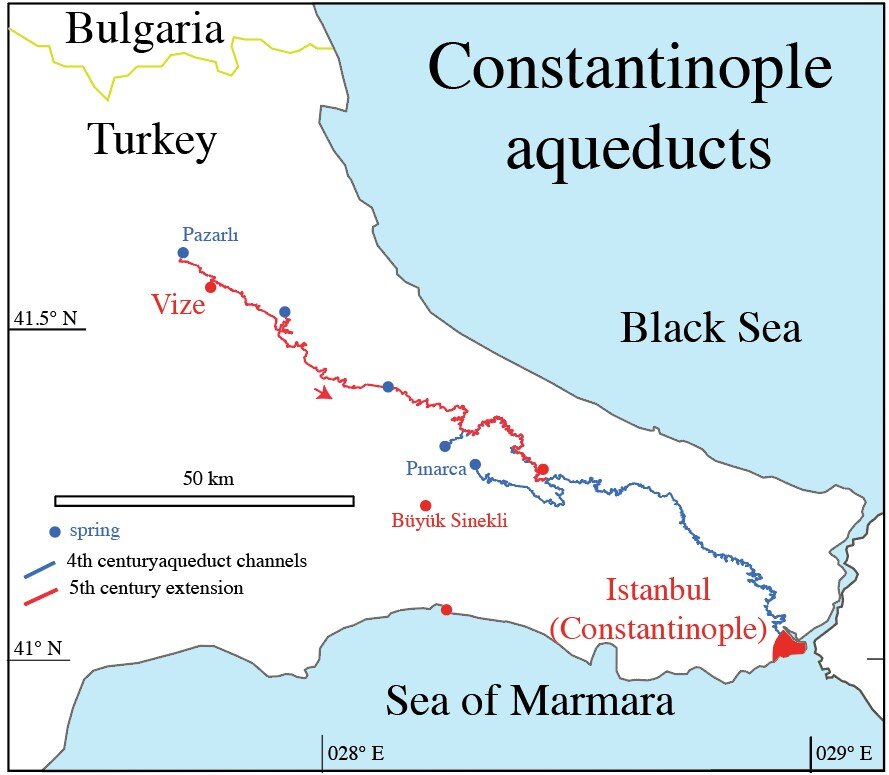Welcome to DU!
The truly grassroots left-of-center political community where regular people, not algorithms, drive the discussions and set the standards.
Join the community:
Create a free account
Support DU (and get rid of ads!):
Become a Star Member
Latest Breaking News
Editorials & Other Articles
General Discussion
The DU Lounge
All Forums
Issue Forums
Culture Forums
Alliance Forums
Region Forums
Support Forums
Help & Search
Anthropology
Related: About this forumThe Aqueduct of Constantinople: Managing the longest water channel of the ancient world
From phys.org

Aqueducts are very impressive examples of the art of construction in the Roman Empire. Even today, they still provide new insights into aesthetic, practical and technical aspects of construction and use. Scientists at Johannes Gutenberg University Mainz (JGU) investigated the longest aqueduct of the time, the 426-kilometer-long Aqueduct of Valens supplying Constantinople, and revealed new insights into how this structure was maintained. It appears that the channels had been cleaned of carbonate deposits just a few decades before the site was abandoned.
...
The Roman Empire was ahead of its time in many ways, with a strong commitment to building infrastructure for its citizens. This includes architecturally inspiring temples, theaters and amphitheaters, but also a dense road network and impressive harbors and mines. "However, the most ground-breaking technical achievement of the Roman Empire lies in its water management, particularly its long-distance aqueducts that delivered water to cities, baths and mines," said Dr. Gül Sürmelihindi from the Geoarchaeology group at Mainz University. Aqueducts were not a Roman invention, but in Roman hands, these long-distance aqueducts were developed further and extensively diffused throughout one of the largest empires in history.
Almost every city in the Roman Empire had an ample supply of fresh running water, in some cases actually with a larger volume than is the case today. "These aqueducts are mostly known for their impressive bridges, such as the Pont du Gard in southern France, which are still standing today after two millennia. But they are most impressive because of the way problems in their construction were solved, which would be daunting even for modern engineers," said JGU Professor Cees Passchier. More than 2,000 long-distance Roman aqueducts are known to date, and many more are awaiting discovery. The study undertaken by Dr. Gül Sürmelihindi and her research team focuses on the most spectacular late-Roman aqueduct, the water supply lines of Constantinople, now Istanbul in present-day Turkey.
...
In AD 324, the Roman Emperor Constantine the Great made Constantinople the new capital of the Roman Empire. Although the city lies at the geopolitically important crossroads of land routes and seaways, fresh water supply was a problem. A new aqueduct was therefore built to supply Constantinople from springs 60 kilometers to the west. As the city grew, this system was expanded in the fifth century to springs that lie 120 kilometers from the city in a straight line. This gave the aqueduct a total length of at least 426 kilometers, making it the longest of the ancient world. The aqueduct consisted of vaulted masonry channels large enough to walk through, built of stone and concrete; 90 large bridges, and many tunnels up to 5 kilometers long.
more ...
2 replies
 = new reply since forum marked as read
Highlight:
NoneDon't highlight anything
5 newestHighlight 5 most recent replies
= new reply since forum marked as read
Highlight:
NoneDon't highlight anything
5 newestHighlight 5 most recent replies
The Aqueduct of Constantinople: Managing the longest water channel of the ancient world (Original Post)
Jim__
May 2021
OP
PBS doc a few years ago showed all the ancient features + went into the aqueduct + water wells.
pansypoo53219
May 2021
#1
pansypoo53219
(22,883 posts)1. PBS doc a few years ago showed all the ancient features + went into the aqueduct + water wells.
they did a few ancient cities. athens? an egyptian one.
Judi Lynn
(164,049 posts)2. Thank you for sharing this information. Totally new to me, so glad to finally have read about it!
Had to look for images immediately. Here's a link to google images for the aqueduct:

https://tinyurl.com/tnmt33ez
Unbelievable! Thank you, so much.